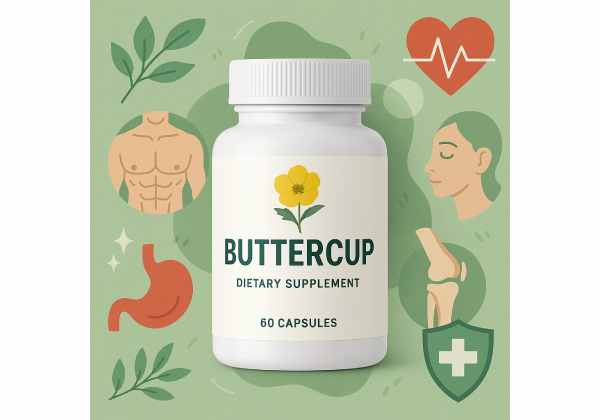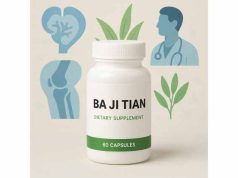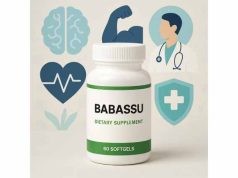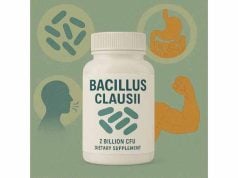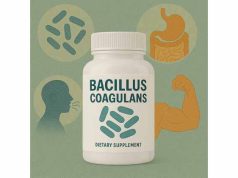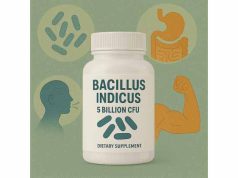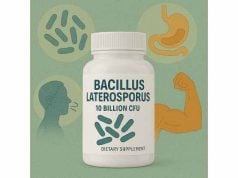Buttercup, a common wildflower with a charming golden glow, has long been admired for its beauty—but its medicinal legacy is less widely known. Traditionally used in folk medicine for everything from pain relief to skin ailments, buttercup (Ranunculus species) contains a variety of active compounds that have intrigued herbalists for centuries. While modern research has started to investigate its properties, buttercup is primarily valued for its potential anti-inflammatory, antimicrobial, and analgesic effects. However, due to its natural toxicity in fresh form, it’s crucial to understand the correct uses, benefits, and safety precautions. This comprehensive guide explores buttercup’s benefits, evidence-based uses, proper dosage, potential side effects, and what you need to know before considering it as a supplement.
Key Takeaways
- Buttercup offers potential anti-inflammatory and pain-relieving properties, traditionally used for skin and joint complaints.
- Raw buttercup is toxic—it should never be consumed or applied directly in its fresh form; only properly prepared extracts or remedies are considered for use.
- Historically used in poultices and topical applications, but internal use is rare and must be approached with extreme caution.
- Modern interest focuses on its antimicrobial and anti-swelling effects, though scientific evidence in humans remains limited.
- Consult a qualified healthcare provider before any use of buttercup, especially for supplements or homemade preparations.
Table of Contents
- Buttercup Identification, Uses, and Historical Background
- Scientific Principles and Buttercup’s Biological Impact
- Therapeutic Benefits and Evidence-Based Uses of Buttercup
- Safety Risks, Side Effects, and Interactions of Buttercup
- Proper Dosage, Administration, and Usage of Buttercup
- Buttercup: Frequently Asked Questions (FAQ)
Buttercup Identification, Uses, and Historical Background
Buttercup refers to a group of flowering plants belonging to the Ranunculus genus, with over 400 species distributed worldwide. The most familiar are the bright yellow varieties carpeting meadows in spring and summer, recognized by their glossy petals and cup-shaped blooms. Despite their innocent appearance, buttercups have a surprisingly complex relationship with both traditional herbalism and contemporary medicine.
Botanical Profile and Active Compounds
Buttercups are low-growing, perennial or annual plants found in temperate regions. The most common medicinal species include Ranunculus acris (meadow buttercup), Ranunculus bulbosus (bulbous buttercup), and Ranunculus repens (creeping buttercup). Their primary distinguishing feature is a vivid, lacquered yellow flower with five petals.
The plant contains several notable chemical constituents, including:
- Ranunculin: A glycoside that, when the plant is crushed or chewed, converts to protoanemonin—a compound responsible for most of the plant’s toxicity and medicinal activity.
- Protoanemonin: A volatile, irritant oil that possesses strong antimicrobial and anti-inflammatory effects but can cause skin and mucous membrane irritation.
- Flavonoids, saponins, and other phenolic compounds that may support antioxidant activity.
Traditional and Folk Medicine Uses
Buttercup’s medicinal uses stretch back to ancient times, particularly in Europe and Asia, where it was valued for its ability to relieve pain, reduce swelling, and treat skin conditions. Key historical uses include:
- Topical poultices: Fresh buttercup was applied (with caution) to painful joints, neuralgia, or skin infections to provoke blistering and draw out inflammation. The irritant effect was thought to stimulate healing.
- Wart and callus removal: Buttercup sap was sometimes dabbed on warts or calluses to break down toughened skin, but this was risky and often painful.
- Folk remedies for headaches and rheumatism: Some traditions involved using dried, processed buttercup in poultices or as an ingredient in ointments for headache or muscle pain.
Modern Applications and Research Interest
While the use of buttercup has declined due to concerns about toxicity and the development of safer, more effective remedies, there has been renewed scientific interest in its bioactive compounds—especially for their antimicrobial and anti-inflammatory potential.
Today, buttercup is rarely used internally and is largely studied for its:
- Potential in topical formulations for pain and inflammation (with rigorous safety protocols)
- Antimicrobial properties against bacteria and fungi in laboratory studies
- Role as a cautionary example of how plant-derived compounds can be both healing and harmful
It is critical to understand that buttercup is never safe to eat raw or unprocessed. Fresh buttercup can cause severe irritation, blistering, and even poisoning. Only properly prepared extracts—free from protoanemonin—are ever considered for supplemental or topical use, and only under expert guidance.
Cultural and Symbolic Uses
Beyond medicine, buttercup has cultural symbolism as a harbinger of spring and childhood play (“do you like butter?” games). Despite this cheerful association, its medicinal past is complex and demands a careful, evidence-informed approach.
Scientific Principles and Buttercup’s Biological Impact
Exploring the science behind buttercup’s effects reveals why this attractive flower is both intriguing and potentially hazardous. Buttercup’s active compounds are a double-edged sword: while they demonstrate promising pharmacological activities in laboratory studies, their toxicity demands utmost respect and proper processing.
Conversion of Ranunculin to Protoanemonin: The Heart of Buttercup’s Potency
The most critical scientific process associated with buttercup’s effects is the enzymatic conversion of ranunculin (a relatively harmless compound) to protoanemonin when the plant’s tissues are damaged. Protoanemonin is a volatile, irritant oil responsible for both the beneficial and harmful effects of buttercup.
- Topical Action: Protoanemonin acts as a strong irritant, causing blistering and inflammation when applied to skin or mucous membranes. Historically, this was harnessed in small, controlled amounts to increase blood flow and relieve pain in underlying tissues—a practice known as “counterirritation.”
- Antimicrobial Properties: Laboratory research indicates protoanemonin and related compounds possess potent antibacterial and antifungal effects, inhibiting the growth of various pathogenic microbes. This may explain buttercup’s historical use for skin infections and wounds.
- Anti-Inflammatory and Analgesic Effects: Recent in vitro and animal studies suggest that certain buttercup extracts (properly processed to remove or neutralize protoanemonin) can suppress inflammatory cytokines, reduce swelling, and modulate pain signals. These effects are primarily linked to flavonoids, saponins, and other phenolic antioxidants.
Toxicology: Why Fresh Buttercup Is Unsafe
Protoanemonin is highly toxic in its raw form. Direct contact can cause:
- Skin irritation and blistering
- Severe inflammation of the mouth, throat, and digestive tract if ingested
- Vomiting, diarrhea, dizziness, and in rare cases, convulsions
When buttercup is dried or heat-processed, protoanemonin rapidly breaks down into anemonin, a much less toxic compound. Only extracts prepared from dried plant material are considered for potential use in supplements or topical products—and always in carefully controlled amounts.
Mechanisms of Action in the Body
- Counterirritant effect: The irritant properties of protoanemonin stimulate increased blood flow to the area of application, which may help reduce pain or inflammation in deeper tissues through nervous system reflexes.
- Modulation of immune response: Laboratory studies show some buttercup extracts can suppress inflammatory markers and oxidative stress, supporting traditional uses for joint or skin inflammation.
- Antioxidant activity: Flavonoids and phenolic acids in buttercup may neutralize free radicals, providing a degree of cellular protection, although this is less studied compared to other herbs.
Research Limitations and Modern Perspectives
The main challenge with buttercup is balancing its potential benefits with its risks. Modern herbalists and researchers rarely recommend it for internal use. Most promising findings are from topical applications or in vitro studies, and robust human clinical trials are lacking.
As a supplement, buttercup is not widely available or standardized, and its use is mainly of historical and academic interest. The most reliable modern applications involve purified extracts or creams for specific topical indications—always avoiding raw or home-prepared remedies unless guided by an expert.
Summary of Buttercup’s Scientific Profile
- Offers antimicrobial and anti-inflammatory effects in laboratory settings.
- Raw, fresh buttercup is toxic; only dried or specially processed forms are ever considered for use.
- Most applications are topical and focused on pain, swelling, or skin complaints.
- Internal use is outdated and unsafe without expert supervision.
- More research is needed to clarify safe, effective therapeutic protocols.
Therapeutic Benefits and Evidence-Based Uses of Buttercup
Despite its dangers, buttercup has a long-standing reputation in traditional medicine as a remedy for pain, inflammation, and infections—provided it is used safely and appropriately. Modern science has begun to validate some historical uses, but evidence is still emerging, and caution remains paramount.
1. Topical Analgesic and Anti-Inflammatory Uses
- Joint and Muscle Pain: Historically, poultices made from dried and heat-processed buttercup were applied to sore joints, arthritic hands, or aching muscles. The counterirritant effect may distract from deeper pain and increase blood flow, promoting temporary relief.
- Nerve Pain (Neuralgia): Traditional practitioners sometimes applied buttercup preparations to sites of nerve pain, harnessing its ability to provoke mild inflammation and redirect pain signals.
- Arthritis and Rheumatism: Limited laboratory evidence suggests buttercup extracts can inhibit inflammatory markers, lending some support to its use in chronic joint inflammation. However, clinical data in humans is lacking, and safer alternatives exist.
2. Treatment of Skin Conditions
- Warts and Calluses: Buttercup sap was historically used as a folk remedy for breaking down warts, calluses, and other tough skin growths. While protoanemonin is effective at dissolving keratin, the risk of burns and scarring makes this practice obsolete and discouraged today.
- Minor Wounds and Infections: Buttercup’s antimicrobial properties have been demonstrated in lab studies, where its extracts can inhibit common bacteria and fungi. In history, dried buttercup infusions were occasionally used as washes for minor wounds, but this is not a modern medical recommendation.
3. Respiratory and Systemic Folk Uses
- Cold and Cough Remedies: In some traditions, diluted buttercup extracts were used in teas or tinctures for coughs or chest congestion, capitalizing on its expectorant and mildly numbing properties. However, given the risk of irritation and toxicity, this practice is not supported in modern herbalism.
- Headaches and Migraines: Topical application to the forehead was sometimes used as a remedy for headaches, leveraging the counterirritant effect. Again, this approach is now largely replaced by safer therapies.
4. Emerging Research and Potential Applications
- Antimicrobial and Antifungal Effects: Recent in vitro studies show that buttercup extracts can inhibit a range of bacteria and fungi, including some antibiotic-resistant strains. These findings have sparked interest in developing new topical antimicrobial agents, though much more research is needed before clinical application.
- Antioxidant Activity: The flavonoid content of buttercup may provide some antioxidant benefit, helping to neutralize free radicals and protect skin cells from environmental stressors. However, other plants offer greater antioxidant potency with fewer risks.
5. Buttercup in Homeopathy and Modern Herbal Blends
In homeopathic practice, highly diluted buttercup (Ranunculus bulbosus) is sometimes used for specific nerve and muscle pains. These remedies contain such small quantities that toxicity is not a concern, but their efficacy is debated.
Some modern natural pain relief creams or ointments include highly purified buttercup extracts alongside other botanicals, marketed for arthritis or muscle soreness. These are typically formulated to exclude toxic protoanemonin.
Who Should (and Shouldn’t) Consider Buttercup Remedies?
- Suitable for: Individuals seeking traditional, topical pain or swelling remedies—only with products that are professionally formulated and proven safe.
- Not suitable for: Anyone considering internal use, children, pregnant or breastfeeding women, or those with sensitive skin.
Comparing Buttercup to Safer Alternatives
While buttercup’s unique chemistry offers intriguing effects, its risks often outweigh its benefits. For most wellness goals—pain, inflammation, skin health—safer, well-studied herbs such as arnica, calendula, or turmeric are preferred.
Key Takeaways on Buttercup’s Benefits
- Most applications are topical, and only with non-toxic, properly processed extracts.
- Historical benefits are partly validated by modern research, but safer herbs are available.
- Never use fresh buttercup internally or externally due to significant toxicity.
Safety Risks, Side Effects, and Interactions of Buttercup
The safety of buttercup is a subject of ongoing concern and essential awareness, especially for those interested in natural remedies. While many plants in herbal medicine offer broad safety margins, buttercup is not one of them. The main caution comes from its potent irritant compounds, most notably protoanemonin, which can cause significant adverse reactions in humans and animals when not handled correctly.
Understanding the Toxicity of Buttercup
- Raw and Fresh Plant Dangers: Buttercup’s signature yellow beauty conceals a serious hazard. When the plant is crushed, chewed, or even handled excessively, ranunculin transforms into protoanemonin, an oily substance responsible for the majority of toxic effects. This compound is volatile and causes irritation, blistering, and inflammation on contact.
- Effects of Ingestion: Swallowing fresh buttercup or its sap is extremely risky. Symptoms may include a burning sensation in the mouth, throat swelling, excessive salivation, abdominal pain, vomiting, diarrhea, and in rare cases, dizziness, convulsions, or even death. Animals grazing on buttercup-rich pastures have suffered fatal poisonings, and the risk to humans is substantial.
- Topical Risks: Even skin contact with the raw plant can provoke redness, itching, painful blisters, and lasting burns. Sensitive individuals, children, and those with pre-existing skin conditions are especially at risk.
Processed Buttercup and Extracts: Reduced but Not Eliminated Risk
When dried or heat-processed, buttercup’s protoanemonin converts to anemonin, a much less toxic compound. Professionally prepared extracts are made from dried plant material to minimize risk, but quality control is crucial. Despite reduced toxicity, even these extracts can provoke irritation or allergic reactions in sensitive users.
Possible Side Effects from Topical or Supplemental Use
- Skin irritation: Even processed extracts may cause local irritation, redness, or rash, especially in those with sensitive skin or when applied for extended periods.
- Allergic reactions: Rare but possible, presenting as itching, swelling, or hives.
- Eye and mucous membrane exposure: Accidental contact with eyes or open wounds should be avoided, as it can result in severe pain and inflammation.
- Gastrointestinal distress: Inadvertent ingestion of even dried buttercup products may cause mild stomach upset, though this is rare with reputable supplements.
Drug Interactions and Contraindications
Due to the irritant nature of buttercup and lack of extensive clinical research, information on drug interactions is limited, but caution is warranted:
- Avoid with other irritants: Do not combine buttercup with other topical irritants or aggressive therapies (like strong acids, bases, or abrasives).
- Immunosuppressed individuals: Those with weakened immune systems should avoid buttercup extracts due to the theoretical risk of excessive irritation or immune response.
- Pregnancy and breastfeeding: Absolutely avoid all forms of buttercup in pregnancy and while breastfeeding. Its compounds can cross into breastmilk, and the safety profile is unacceptable for developing babies.
Accidental Poisoning: What to Do
If you suspect buttercup poisoning (from ingestion or significant skin contact), seek medical help immediately. Do not induce vomiting. Rinse the affected skin or mouth with copious amounts of water and contact poison control or emergency services for further guidance.
Safe Handling and Storage
- Always wear gloves when handling fresh buttercup.
- Keep all forms (including dried or processed extracts) out of reach of children and pets.
- Store in a cool, dry place, clearly labeled and away from food products.
Summary: Safety First with Buttercup
- Never ingest raw or unprocessed buttercup.
- Use only commercially prepared extracts from reputable suppliers.
- Always conduct a skin patch test before topical use.
- Discontinue immediately at the first sign of irritation or allergic response.
- Consult your healthcare provider before considering any form of buttercup, especially if you have health conditions, take medication, or are pregnant/nursing.
Buttercup’s striking color and medicinal lore may attract attention, but its risks demand a respectful and highly cautious approach to any use.
Proper Dosage, Administration, and Usage of Buttercup
Determining a safe and effective dosage for buttercup is particularly challenging due to the plant’s inherent toxicity and the lack of modern, standardized supplement products. Unlike many herbs, buttercup is not recommended for routine self-medication, and any medicinal use must be approached with extreme caution and preferably under professional guidance.
Traditional Preparation and Safe Processing
- Drying and Heat Treatment: Traditional and modern herbalists only consider buttercup after careful drying or heat processing, which neutralizes protoanemonin by converting it to the far less toxic anemonin. Never use fresh buttercup for home remedies or supplements.
- Tinctures and Extracts: Some professional herbalists use highly diluted tinctures or topical creams, always made from dried material, and frequently combined with soothing herbs to offset any residual irritation.
General Dosage Guidelines
There are no universally accepted dosages for buttercup. When used in topical formulations, it’s always in very low concentrations, and duration is brief.
- Topical Use: Commercially prepared ointments or creams should specify the percentage of buttercup extract and directions for use. Typically, a pea-sized amount is applied to the affected area 1–2 times daily, for no more than several days.
- Tinctures: Homeopathic remedies may use dilutions of Ranunculus bulbosus in extremely low (often undetectable) concentrations, following the “like cures like” philosophy. Consult a trained homeopath for dosing details.
- Infusions and Teas: Traditional teas or infusions are largely obsolete and are not recommended due to the risk of protoanemonin exposure.
Step-By-Step Safe Use Recommendations
- Consult a Qualified Herbalist or Healthcare Provider: Before using any buttercup product, seek expert advice. Most reputable practitioners will recommend safer alternatives.
- Patch Test First: Apply a tiny amount of any topical buttercup extract to an inconspicuous area and wait 24 hours for signs of irritation.
- Follow Manufacturer Directions: Only use products from reliable sources and adhere strictly to labeled instructions. Do not improvise with raw or homemade preparations.
- Limit Duration: Even when tolerated, limit topical use to no more than 3–5 consecutive days.
- Monitor for Adverse Effects: Discontinue use immediately if you experience burning, itching, swelling, or systemic symptoms.
Who Should Never Use Buttercup?
- Children under 12 years old
- Pregnant or breastfeeding women
- Individuals with sensitive skin, eczema, or open wounds
- Anyone with a history of plant allergies, especially to Ranunculaceae family members
Practical Tips for Use
- Do not attempt to make buttercup tinctures or extracts at home unless you are an experienced herbalist.
- Never use fresh buttercup as a poultice, in teas, or in homemade remedies.
- Store all buttercup products in childproof containers and clearly mark them as potentially toxic.
Alternatives for Safer Herbal Care
Given the risks, many practitioners recommend arnica, calendula, or comfrey as safer alternatives for topical pain relief, swelling, and skin healing. These herbs offer robust evidence for safety and effectiveness when used appropriately.
Summary Table: Buttercup Usage
| Application | Form | Typical Dosage | Duration |
|---|---|---|---|
| Topical pain relief | Cream/Ointment | Pea-sized amount, 1–2x/day | Max 3–5 days |
| Homeopathic remedy | Dilute tincture | As directed by practitioner | Variable |
| Internal use | None recommended | N/A | N/A |
Key Takeaway: If you’re not a trained herbalist or do not have access to a standardized, commercially prepared product, it is best to avoid using buttercup entirely.
Buttercup: Frequently Asked Questions (FAQ)
Is buttercup safe to use as a supplement?
Buttercup is generally not considered safe for use as a supplement due to its toxicity. Only professionally processed extracts from dried buttercup may be used topically, and even then, under expert guidance.
Can you eat buttercup flowers or leaves?
No, buttercup flowers and leaves are toxic when raw or unprocessed. Eating them can cause severe irritation of the digestive tract and should always be avoided.
What is buttercup used for in herbal medicine?
Historically, buttercup was used for joint pain, skin issues, and as a counterirritant in poultices. Today, safer herbal alternatives are recommended for most of these uses.
Are there any side effects of topical buttercup?
Topical buttercup may cause redness, burning, blisters, or rash. Discontinue immediately if irritation occurs and avoid use on broken skin.
Is buttercup poisonous to pets and livestock?
Yes, buttercup is poisonous to most animals, including pets and grazing livestock. Symptoms include drooling, blistering, diarrhea, and severe discomfort.
Are there safe alternatives to buttercup for pain or inflammation?
Yes, herbs like arnica, calendula, and comfrey are generally safer and more effective for pain relief, swelling, or minor skin wounds.
What should I do if I suspect buttercup poisoning?
Seek immediate medical or veterinary help. Do not induce vomiting. Rinse affected skin or mouth thoroughly and contact poison control or emergency services right away.
Disclaimer:
The information provided in this article is for educational purposes only and should not be considered a substitute for professional medical advice, diagnosis, or treatment. Always consult a healthcare professional before using any herbal supplement, especially those with known toxicity risks like buttercup.
If you found this guide helpful, please share it with friends or on social media platforms like Facebook or X (Twitter). Your support helps us continue to deliver accurate, in-depth wellness resources. Thank you for helping us spread trustworthy health information!

